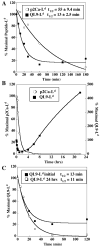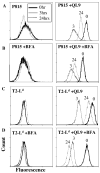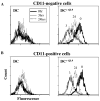Cellular uptake followed by class I MHC presentation of some exogenous peptides contributes to T cell stimulatory capacity
- PMID: 17169430
- PMCID: PMC2547883
- DOI: 10.1016/j.molimm.2006.11.016
Cellular uptake followed by class I MHC presentation of some exogenous peptides contributes to T cell stimulatory capacity
Abstract
The T cell stimulatory activity of peptides is known to be associated with the cell surface stability and lifetime of the peptide-MHC (pepMHC) complex. In this report, soluble high-affinity T cell receptors (TCRs) that are specific for pepMHC complexes recognized by the mouse CD8+ clone 2C were used to monitor the cell surface lifetimes of synthetic agonist peptides. In the 2C system, L(d)-binding peptide p2Ca (LSPFPFDL) has up to 10,000-fold lower activity than peptide QL9 (QLSPFPFDL) even though the 2C TCR binds to p2Ca-L(d) and QL9-L(d) complexes with similar affinities. Unexpectedly, p2Ca-L(d) complexes were found to have a longer cell surface lifetime than QL9-L(d) complexes. However, the strong agonist activity of QL9 correlated with its ability to participate in efficient intracellular delivery followed by cell surface expression of the peptide, resulting in high and persistent surface levels of QL9-L(d). The ability of target cells to take up and present QL9 was observed with TAP-deficient cells and TAP-positive cells, including dendritic cells. The process was brefeldin A-sensitive, indicating a requirement for transport of the pepMHC through the ER and/or golgi. Thus, strong T cell stimulatory activity of some pepMHC complexes can be accomplished not only through long cell surface lifetimes of the ligand, but through a mechanism that leads to delayed presentation of the exogenous antigen after intracellular uptake.
Figures






References
-
- Ackerman AL, Cresswell P. Cellular mechanisms governing cross-presentation of exogenous antigens. Nat Immunol. 2004;5:678–84. - PubMed
-
- Ackerman AL, Kyritsis C, Tampe R, Cresswell P. Access of soluble antigens to the endoplasmic reticulum can explain cross-presentation by dendritic cells. Nat Immunol. 2005;6:107–13. - PubMed
-
- Alexander J, Payne JA, Murray R, Frelinger JA, Cresswell P. Differential transport requirements of HLA and H-2 class I glycoproteins. Immunogenetics. 1989;29:380–399. - PubMed
-
- Baker MB, Gagnon JS, Biddison EW, Wiley CD. Conversion of a T cell antagonist into an agonist by repairing a defect in the TCR/peptide/MHC interface: implications for TCR signaling. Immunity. 2000;13:475–84. - PubMed
Publication types
MeSH terms
Substances
Grants and funding
LinkOut - more resources
Full Text Sources
Molecular Biology Databases
Research Materials
Miscellaneous

